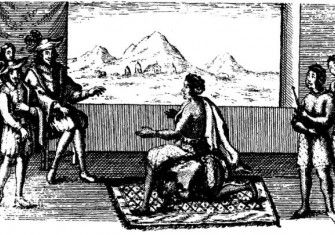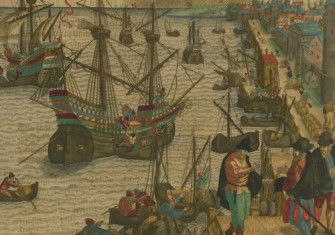Habsburg Iberia Points West
The 16th century was a time of crisis and change for Portugal’s empire.

The Aviz dynasty, which ruled Portugal from 1385 until 1580, included a number of remarkable and wise monarchs. Unfortunately, King Sebastian (r.1557-78) was not one of them. Rather, he was an immature and headstrong youth. His insistence on continuing the reconquista (the Christian reconquest of Iberia from its Islamic rulers) into Morocco led not only to his death but ultimately to the end of the House of Aviz. When Sebastian died in Morocco, the throne was inherited by his great uncle, Cardinal Henrique. He unsuccessfully petitioned Pope Gregory XIII for a dispensation to marry, in spite of his advanced age of 66, in a final effort to continue the Aviz line and avoid a foreign king ruling Portugal.
There were several claimants to the throne, all with equally legitimate claims. The situation is nicely summarised in a text from 1627:
When King D. Henrique ruled following the death of King D. Sebastião, his [great] nephew, he was of such an advanced age of sixty-six when his reign began that there began to be debates as to who would succeed him. The claimants were the Catholic King, D. Philip II of Castile, The Duchess of Bragança, the Prince of Parma, the Duke of Savoy, and Lord D. António.
They all claimed to be nephews and nieces of King D. Henrique, children of his brothers or sisters and were all equal in their relation to him. All were grandchildren of King D. Manuel I.
Cardinal-King Henrique died in 1580 and what he had sought so hard to avoid came to pass. The person in the strongest position (geographically, financially and strategically) to inherit was Philip II of Castile and he lost little time in consolidating his Portuguese supporters, buying more through generous payments and, ultimately, sending troops commanded by the Duke of Alba to invade Portugal, having himself crowned king in 1580. He said: ‘I inherited it, I bought it, and I conquered it.’ This period (1580-1640), when Portugal was one of many Iberian kingdoms ruled from Madrid, became known as the Union of the Iberian Crowns. There was some popular support for António, which Philip and his agents were quickly able to overcome, forcing him to flee to the Azores and then abroad.
Philip II of Castile (I of Portugal) was arguably the wealthiest and most powerful monarch of his age and his new Portuguese possessions, especially Brazil, its largest and potentially most profitable, only ensured this position. The Spanish king also had no end of enemies and defending his global empire would be difficult and expensive. Spain was threatened by the Protestant Dutch and English and others in northern Europe, the Ottomans and many powers, who were attacking Portuguese Asia.
Nuestra Señora de la Concepción. In the process, he acquired a great deal of Spanish silver (and some gold and jewels) destined for shipment to Panama and on to Spain. Drake had exposed the Spanish Pacific ports to attack – a major flaw in Spanish defences.
The way to stop future Drakes from entering the Pacific was to fortify the Strait of Magellan, which is what Philip II and his advisers decided to do. At the same time, Brazil was in need of defence by its new monarch. The French continued their inroads along the Brazilian coast and the many wars with the natives were draining colonial manpower. In 1581, after a great deal of preparation, Philip dispatched Diego Flores de Valdés as the Captain-General of a fleet that would fortify and settle the strait. Another, and no less important objective, was to assist the Brazilian colonists in their ongoing struggles and ensure their loyalty to the new monarch, thus securing Brazil firmly within the Habsburgs’ orbit.
Our understanding of this expedition, although documented in detail, has relied heavily on the account written by the governor of the planned straits settlement, Pedro Sarmiento de Gamboa. Sarmiento’s account is coloured by his dislike of Diego Flores de Valdés. His ‘emotional and opinionated version of events overwhelmed all other voices regarding the armada and influenced generations of historians’, writes Carla Rahn Phillips, a historian of early modern Spain. The account, written by the official scribe, Pedro de Rada, was never published and remained in private hands until 1999, but has now been translated and edited by Phillips as The Struggle for the South Atlantic: The Armada of the Strait, 1581-84.
It was in the period from 1580 to 1640 that the Portuguese empire experienced a radical shift from one based on profit from Asian trade to that of the sale of sugar from Brazil. In much of the historical writing since 1640, the Portuguese blamed the Spanish for the decline of their empire, especially their Asian holdings. The reality was, however, that the Dutch and, to a lesser extent, the English, the Omanis and the Persians, were responsible. By 1654, with the Portuguese loss of Sri Lanka and the expulsion of the Dutch from Brazil, it was the Atlantic segments of the Portuguese empire that became the most lucrative. Well before that, however, the Spanish were quick to protect their empire, including its most profitable Portuguese segment, as demonstrated by the expedition of Flores.
Having Rada’s account published, along with additional documentation on this expedition, provides a clearer and more balanced picture of a critical Spanish effort in the Strait of Magellan.
Timothy Coates is Professor of History at the College of Charleston.






